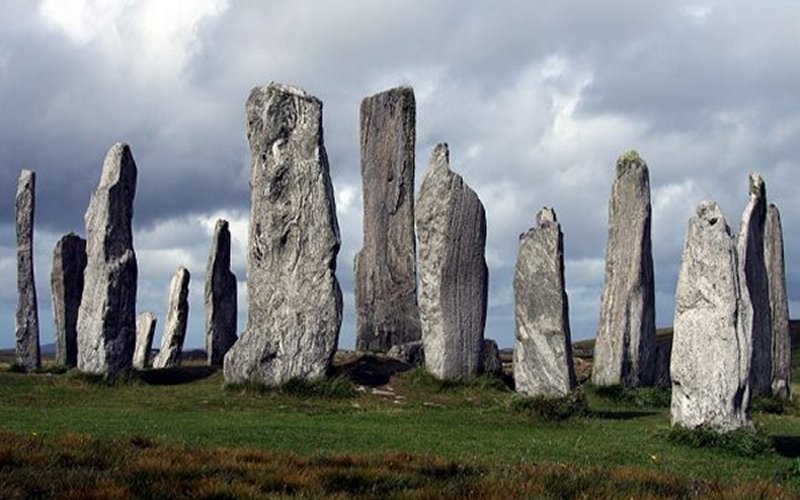Callanish Stone Complex: Sacred Place On The Isle Of Lewis In Scotland
A. Sutherland - AncientPages.com - The Callanish Stone Complex (Scottish Gaelic: Calanais) is located on the Isle of Lewis, the outer Hebridian island, west of Scotland. This megalithic landmark is very old and impressive; it originates in Neolithic Britain.
Situated on a prominent ridge overlooking Loch Roag, on Lewis (Western Isles), the Callanish stones are visible from a considerable distance.
Callanish Stones is located near Callanish village, Isle of Lewis, Outher Hebrids, Scotland. Image credit: Chmee2 - CC BY-SA 3.0
A particular atmosphere of mystery dominates over the impressive physical presence of the stones and their total dominance in the landscape.
The main monument at Callanish dates back to approximately 3,000 BC. The Isle of Lewis at the time was inhabited by Stone Age farmers who occupied small villages around the Outer Hebrides.
At Callanish, the monoliths were quarried from one of the oldest rocks in Britain, the so-called Lewisian gneiss stone, deriving from the Isle of Lewis, and erected carefully in a circle. The monument's stability was essential, and low mounds of earth and rocks were added to the base of each upright because of the problems of digging sufficiently deep sockets.
The central stone was set in place at this time. The three rows running away to the south, east, and west were likely added soon after. Today, the avenue comprises twenty stones and runs to the north.
A cross-shaped setting of standing stones is centered on a circle of rocks, which contains a vast, 4.75m high and 30cm thick megalith at the center, and a small, chambered cairn, which is 7m in diameter and is probably, a later addition to the complex.
All this gives clues to how vital the area was to prehistoric peoples.
Engraving from a paper by Henry Callendar, 1854
The arrangement - with lines of stones radiating in four directions from the ring - is unique. However, its purpose is unclear and does not explain whether the stone alignments were constructed at the same time as the ring or later.
However, the majestic Callanish Stones are associated with astronomical events, especially concerning the Moon's movements.
Aubrey Burl, in his book "Circles of Stone The Prehistoric Rings of Britain and Ireland," mentions Diodorus Siculus, the famous Greek historian who died sometime after 21 BC, who first provided an astronomical explanation of the site:
"He wrote of a 'spherical temple' in Britain, and this was believed to have referred to Stonehenge. However, the statement that 'the moon as viewed from this island appears to be but a little distance from the earth' refers to something impossible at the latitude of Stonehenge. Instead, it exactly describes the southern moon 'behavior' at Callanish, where it seems "to roll along the top of the skyline."
Callanish was a sacred place to ancient people, and it remained an active focus for the prehistoric religious activity for at least 1500 years.
Like many other prehistoric stone circles, Callanish's use focused on various ceremonies and rituals for centuries.
Whether these activities involved the whole community, part of it, or specifically chosen individuals at different times of the year or various stages in life is unknown.
At Callanish, the monoliths were quarried from local gneiss stone and erected carefully in a circle. The monument's stability was clearly important, and low mounds of earth and stones were added to the base of each upright because of the problems of digging sufficiently deep sockets. Credit: Adobe Stock - rachel bibby/EyeEm
Excavations showed that the burial chamber, as mentioned earlier, was a later addition to the complex and had been modified several times.
The land had been cultivated before the circle was erected; a wooden structure may have preceded it. Archaeologists found some human bones and pottery that dates back to about 2200 BC.
There are many myths and legends related to Callanish. The stones were said to be a council of pagan giants, turned to stone by a Christian saint, St Kieran. In another version, the stone material to build Callanish was brought to the island in ships and erected by "black men" under the direction of priests who wore cloaks of colored feathers.
Yet another legend has it that early at Midsummer Sunrise at Callanish, an entity known as the "Shining One" walks up the avenue, heralded by the call of a cuckoo.
The Callanish Stones Site is in charge of Historic Scotland.
Updated on February 24, 2023
Written by – A. Sutherland - AncientPages.com Senior Staff Writer
Copyright © AncientPages.com All rights reserved. This material may not be published, broadcast, rewritten or redistributed in whole or part without the express written permission of AncientPages.com
Expand for referencesReferences:
M. Aubrey B. Milligan Circles of Stone: The Prehistoric Rings of Britain and Ireland
More From Ancient Pages
-
 Older Than Dracula: In Search Of The English Vampire
Myths & Legends | Dec 9, 2022
Older Than Dracula: In Search Of The English Vampire
Myths & Legends | Dec 9, 2022 -
 Roman Leather Toy Mouse Found At Vindolanda
Archaeology | Jun 6, 2023
Roman Leather Toy Mouse Found At Vindolanda
Archaeology | Jun 6, 2023 -
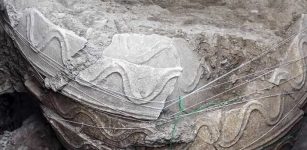 Bizarre Parthian Tomb Sheds Light On Ancient Life In Isfahan, Central Iran
Archaeology | Jun 25, 2020
Bizarre Parthian Tomb Sheds Light On Ancient Life In Isfahan, Central Iran
Archaeology | Jun 25, 2020 -
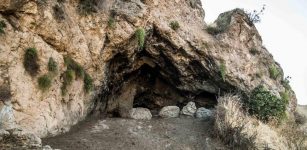 Artifacts And Remnants Of 3,000-Year-Old City Unearthed Near Great Zab River In Iraqi Kurdistan
Archaeology | Jun 5, 2017
Artifacts And Remnants Of 3,000-Year-Old City Unearthed Near Great Zab River In Iraqi Kurdistan
Archaeology | Jun 5, 2017 -
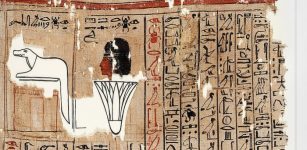 A Magical Handbook For The Afterlife – Insights To Ancient Egyptian Religion, Magic And Secret Knowledge
News | Jul 11, 2023
A Magical Handbook For The Afterlife – Insights To Ancient Egyptian Religion, Magic And Secret Knowledge
News | Jul 11, 2023 -
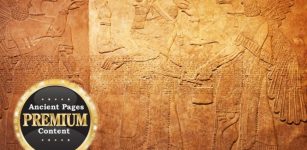 Mysterious Sumerian Star Tablet And Strange Divine Omens – Communication With The Gods – Part 2
Ancient Mysteries | Feb 18, 2021
Mysterious Sumerian Star Tablet And Strange Divine Omens – Communication With The Gods – Part 2
Ancient Mysteries | Feb 18, 2021 -
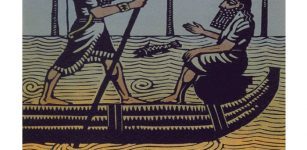 Missing Lines From Epic Of Gilgamesh Shed New Light On Humbaba
Artifacts | Oct 9, 2015
Missing Lines From Epic Of Gilgamesh Shed New Light On Humbaba
Artifacts | Oct 9, 2015 -
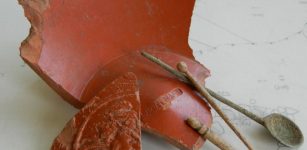 New Evidence Of Roman And Medieval Leicester
Archaeology | Dec 10, 2015
New Evidence Of Roman And Medieval Leicester
Archaeology | Dec 10, 2015 -
 Strange Mummies Of Venzone: Ancient Bodies That Never Decompose Remain An Unsolved Mystery
Featured Stories | Oct 22, 2018
Strange Mummies Of Venzone: Ancient Bodies That Never Decompose Remain An Unsolved Mystery
Featured Stories | Oct 22, 2018 -
 New Evidence Reveals That Humans Settled In Americas At Least 13,000 Years Ago
Archaeology | Sep 4, 2017
New Evidence Reveals That Humans Settled In Americas At Least 13,000 Years Ago
Archaeology | Sep 4, 2017 -
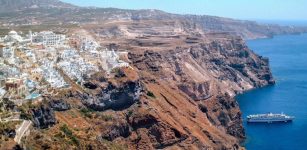 Scientists Attempt To Solve An Ancient Greek Volcano Mystery
Archaeology | Sep 20, 2022
Scientists Attempt To Solve An Ancient Greek Volcano Mystery
Archaeology | Sep 20, 2022 -
 Ancient City Of Adab That Flourished In North Sumer
Civilizations | Jul 19, 2017
Ancient City Of Adab That Flourished In North Sumer
Civilizations | Jul 19, 2017 -
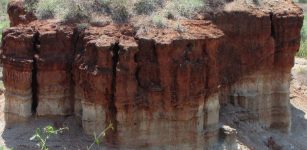 Spectacular Olduvai Gorge And Early Hominid Fossils Found In East Africa
Archaeology | Nov 26, 2016
Spectacular Olduvai Gorge And Early Hominid Fossils Found In East Africa
Archaeology | Nov 26, 2016 -
 Amazing Restoration Of Ancient Roman Vineyard Buried Underneath The Ash Of Mount Vesuvius For 2,000 Years
Archaeology | Nov 27, 2020
Amazing Restoration Of Ancient Roman Vineyard Buried Underneath The Ash Of Mount Vesuvius For 2,000 Years
Archaeology | Nov 27, 2020 -
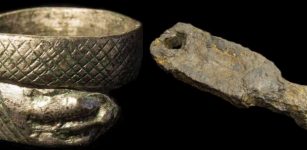 Discovery Of Roman Settlement, Workshops And Artifacts Will Shed Light On Their Life In Northern England
Archaeology | Apr 13, 2017
Discovery Of Roman Settlement, Workshops And Artifacts Will Shed Light On Their Life In Northern England
Archaeology | Apr 13, 2017 -
 Never-Before-Seen Ancient Frescoes Discovered Inside The Dormition Cathedral
Archaeology | Feb 28, 2020
Never-Before-Seen Ancient Frescoes Discovered Inside The Dormition Cathedral
Archaeology | Feb 28, 2020 -
 Valkyries Sigrdriva And Brynhildr: Brave Warriors Who Were Punished By God Odin In Norse And Germanic Mythology
Featured Stories | Apr 4, 2017
Valkyries Sigrdriva And Brynhildr: Brave Warriors Who Were Punished By God Odin In Norse And Germanic Mythology
Featured Stories | Apr 4, 2017 -
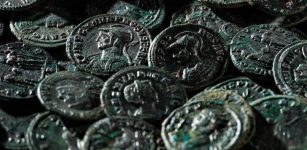 Swiss Farmer Discovered Roman Coins Among Cherry Trees
Archaeology | Nov 22, 2015
Swiss Farmer Discovered Roman Coins Among Cherry Trees
Archaeology | Nov 22, 2015 -
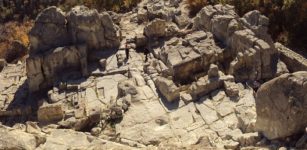 Perperikon – Ancient Secrets Of Bulgaria’s ‘Machu Picchu’ And Europe’s Largest Megalithic Sanctuary
Featured Stories | May 3, 2017
Perperikon – Ancient Secrets Of Bulgaria’s ‘Machu Picchu’ And Europe’s Largest Megalithic Sanctuary
Featured Stories | May 3, 2017 -
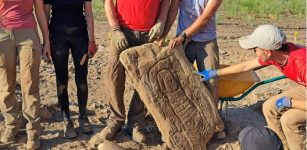 Extraordinary Archaeological Discovery In Spain
Archaeology | Oct 10, 2023
Extraordinary Archaeological Discovery In Spain
Archaeology | Oct 10, 2023

